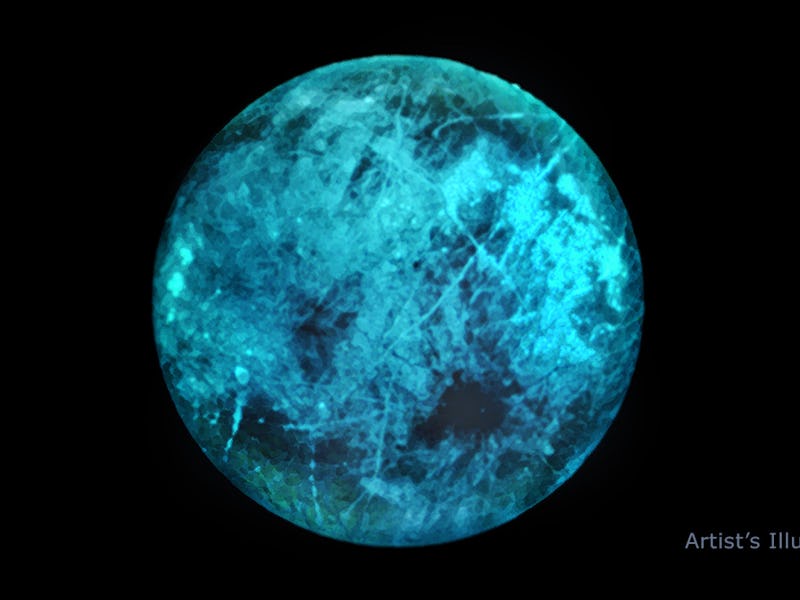Jupiter’s moon Europa may glow in the dark
Radiation makes this icy moon shine.

Although it is the smallest of Jupiter's four Galilean moons, Europa offers scientists a fascinating world to marvel at, with plumes of water vapor, an icy surface, and a possible ocean that may lay beneath.
And now, new research suggests that Europa even glows in the dark.
Scientists simulated Europa's many unusual features in the lab to recreate the moon's environment. They were not prepared for what they found: A greenish or blueish light is emitted from the icy moon due to radiation by its host planet, Jupiter.
"We never imagined that we would see what we ended up seeing," Bryana Henderson, a researcher at NASA's Jet Propulsion Laboratory, and co-author of the new study, said in a statement.
The findings are detailed in a study published Monday in the journal Nature Astronomy.
An illustration of Jupiter's moon Europa showing what it may look like as it glows in the dark.
Another Earth — Europa is the sixth-largest moon of the Solar System — around the same size as our own Moon — and may be our best bet on finding a similar world to Earth within our Solar System.
Jupiter’s moon has a relatively smooth surface like the Earth, save for a few cracks caused by its host planet’s gravitational tides. Europa’s atmosphere is mostly made up of oxygen, although it is rather too thin for humans to be able to breathe. Meanwhile, Europa's surface is made up of ice and salts that are commonly found on Earth.
An artist's concept of icy water plumes erupting on Europa.
Although Europa — one of 79 moons that orbit Jupiter — is the sixth-closest moon to the giant planet, its magnetic field helps protect it from Jupiter’s radiation.
But as the Solar System giant constantly showers Europa with electrons and other particles, the moon's salty compounds are energized. As the salt molecules release that energy, it produces a glimmering light that causes Europa to essentially glow in the dark.
Our Moon is illuminated by the Sun's light reflecting on it. But the parts of it that are in the shadow would not be visible in the darkness of space. But even Europa's dark side has this unique glow. Depending on the compounds that make up the ice, the glow may appear green or blue in color with varying degrees of brightness.
"When we tried new ice compositions, the glow looked different. And we all just stared at it for a while and then said, 'This is new, right? This is definitely a different glow?' So we pointed a spectrometer at it, and each type of ice had a different spectrum," Henderson said.
Hints of habitability — The new discovery not only highlights a fascinating feature unique to Europa, but it could also help in our hunt for signs of life on the icy moon.
Scientists have long suspected that beneath the cracked, icy surface of Jupiter’s moon lies a vast ocean of liquid water, twice as large as the oceans on Earth. And that ultra-cold water may harbor alien life.
NASA is gearing up to launch a mission to Europa in the mid-2020's. The Europa Clipper will observe the moon's surface, and the researchers behind the new discovery are also hoping to be able to observe Europa's glow in real life.
This would not only be a cool sight, but it could also help them map out the chemical composition of Europa's surface by measuring the glow at different wavelengths.
"It's not often that you're in a lab and say, 'We might find this when we get there,'" Murthy Gudipati, a researcher at NASA and lead author of the new study, said in a statement.
"Usually it's the other way around — you go there and find something and try to explain it in the lab. But our prediction goes back to a simple observation, and that's what science is about."
Abstract: Europa’s surface continuously experiences high fluxes of charged particles due to the presence of Jupiter’s strong magnetic field. These high-energy charged particles, including electrons, interact with the ice- and salt-rich surface, resulting in complex physical and chemical processes. Here, we report that Europa ice analogues emit characteristic spectral signatures in the visible region when exposed to high-energy electron radiation. The strongest emission (ice glow) we observed was centred at ~525 nm. We found that the presence of sodium chloride and carbonate strongly quenched, while epsomite enhanced, the radiation-induced ice glow. These emission characteristics could be used to determine the chemical composition of Europa’s surface during night-time low-altitude fly-bys of spacecraft such as the Europa Clipper. We estimate that the Europa Clipper Wide Angle Camera could record between 500 and 280,000 counts per second through different colour filters, depending on the chemical composition of Europa’s surface. Though we focus here on Europa, our study may be relevant to other bodies exposed to high doses of ionizing radiation, such as Io and Ganymede. With its extreme radiation environment, rich surface geology and compositional diversity, the radiation-induced ice glow on Europa could enable more precise surface characterization and provide unique night-time views.